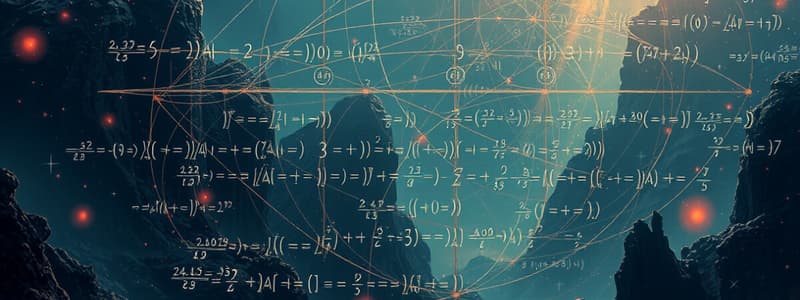Podcast
Questions and Answers
What are quadratic equations?
What are quadratic equations?
- Polynomial equations with a degree of 1
- Polynomial equations with a degree of 3
- Polynomial equations with a degree of 4
- Polynomial equations with a degree of 2 (correct)
What are the roots of the quadratic equation?
What are the roots of the quadratic equation?
Solution of the equation, or the value of the variable that makes the equation true, D = b^2 - 4ac
Two imaginary numbers/conjugate complex numbers occur when D < 0.
Two imaginary numbers/conjugate complex numbers occur when D < 0.
True (A)
A double root occurs when D = 0.
A double root occurs when D = 0.
Irrational conjugates occur when D < 0.
Irrational conjugates occur when D < 0.
What are quadratic inequalities?
What are quadratic inequalities?
Equation having a variable in an absolute value sign is called an _________________.
Equation having a variable in an absolute value sign is called an _________________.
What does Theorem 1 of Absolute Inequalities state if a >/= 0?
What does Theorem 1 of Absolute Inequalities state if a >/= 0?
What does Theorem 2 of Absolute Inequalities state if a < 0?
What does Theorem 2 of Absolute Inequalities state if a < 0?
What are rational equations?
What are rational equations?
What is the domain of a rational equation?
What is the domain of a rational equation?
What is an extraneous solution?
What is an extraneous solution?
An expression with a radical sign or fractional exponents is known as a _________________.
An expression with a radical sign or fractional exponents is known as a _________________.
What are similar radicals?
What are similar radicals?
What is rationalization?
What is rationalization?
What is the domain of an irrational equation?
What is the domain of an irrational equation?
If the index of the domain of an irrational equation is even, then the radicand should be _________________.
If the index of the domain of an irrational equation is even, then the radicand should be _________________.
If the index of the domain of an irrational equation is odd, then the radicand could be _________________.
If the index of the domain of an irrational equation is odd, then the radicand could be _________________.
Two lines are parallel if they have _________________.
Two lines are parallel if they have _________________.
The product of the slope is equal to -1. Two lines are perpendicular if they have _________________.
The product of the slope is equal to -1. Two lines are perpendicular if they have _________________.
What are systems of linear equations?
What are systems of linear equations?
Match the types of systems with their definitions:
Match the types of systems with their definitions:
Flashcards are hidden until you start studying
Study Notes
Quadratic Equations
- Defined as polynomial equations with a degree of 2.
- Fundamental to algebraic solutions and applications.
Roots of the Quadratic Equation
- Solutions are the values of the variable that satisfy the equation.
- The discriminant (D) is calculated as D = b² - 4ac.
Types of Roots
- If D < 0, the equation has two imaginary numbers (conjugate complex numbers).
- If D = 0, there is a double root, meaning real and equal solutions.
- If D > 0, there are irrational conjugates, which are real and unequal solutions.
Quadratic Inequalities
- Inequalities that involve polynomial expressions of degree 2.
- Useful for understanding ranges of values satisfying certain conditions.
Absolute Value Equations
- Contain a variable within an absolute value sign.
- The theorem on absolute inequalities outlines solution ranges based on conditions of 'a':
- If a ≥ 0, |x| < a results in -a < x < a; |x| > a results in x > a or x < -a.
- If a < 0, |x| < a yields no solution, while |x| > a results in all real numbers.
Rational Equations / Fractional Equations
- Comprise equations where both the numerator and denominator are polynomials with integer or rational coefficients.
Domain of Rational Equations
- All real numbers are permissible except those that make the denominator zero.
Extraneous Solutions
- Solutions derived from manipulating equations that do not hold true in the original equation context.
Radical Expressions
- Expressions that include radical signs or fractional exponents.
Similar Radicals
- Radicals share the same integer and radicand, allowing for easy combination or simplification.
Rationalization
- Involves removing radicals from the numerator or denominator of a fraction through multiplication by a rationalizing factor (equal to one).
Domain of Irrational Equations
- Defined by the intersection of all radical expressions' domains within the equation.
Nonnegative Radicands
- Required when the index of the domain in an irrational equation is even.
General Radicands
- Any value is permissible when the index is odd in the domain of an irrational equation.
Parallel Lines
- Two lines are parallel if they share the same slope but different y-intercepts.
Slope Relationships
- The slopes of two lines are negative reciprocals if the product equals -1.
Systems of Linear Equations
- Composed of two or more linear equations using identical variables.
Types of Systems
- Inconsistent: Parallel lines (m₁ = m₂ and b₁ ≠ b₂).
- Consistent Independent: One solution with intersecting lines (m₁ ≠ m₂).
- Consistent Dependent: Infinite solutions with overlapping lines (m₁ = m₂ and b₁ = b₂).
Studying That Suits You
Use AI to generate personalized quizzes and flashcards to suit your learning preferences.




